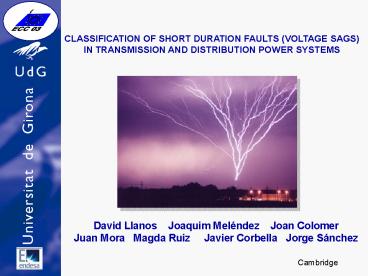Sin t PowerPoint PPT Presentation
Title: Sin t
1
CLASSIFICATION OF SHORT DURATION FAULTS (VOLTAGE
SAGS) IN TRANSMISSION AND DISTRIBUTION POWER
SYSTEMS
David Llanos Joaquim Meléndez Joan Colomer
Juan Mora Magda Ruiz Javier Corbella
Jorge Sánchez
2
SUMMARY
3
CONTENTS
- Voltage Sag Definition
- Significant Information of Voltage Sags
- Classification Method
- Classification Results
- Conclusions
- Future Work
4
VOLTAGE SAG DEFINITION
A voltage magnitude event with a magnitude
between 10 and 90 of the nominal rms voltage
and duration between 0.5 cycles and one minute.
IEEE Std. 1159.
5
SIGNIFICANT INFORMATION OF VOLTAGE SAGS (I)
- Existing methods to characterise voltage sag use
- The lowest of the three-phase voltages
- The longest duration
- In this work, significant proposed descriptors
have been divided in - Three-phase temporal descriptors
- Single-phase temporal descriptors
- Characterisation of faults based on symmetrical
components
6
SIGNIFICANT INFORMATION OF VOLTAGE SAGS (II)
Definition-Three phase voltage sag descriptors
7
SIGNIFICANT INFORMATION OF VOLTAGE SAGS (III)
Definition-Single phase voltage sags descriptors
Vrms p.u.
1.0
Voltage recovery slope
Voltage fall slope
0.9
Single phase sag magnitude
Minimun stage duration
Single phase sag duration
System under fault
Recovery
Fall
Time
8
SIGNIFICANT INFORMATION OF VOLTAGE SAGS (IV)
Characterisation of faults based on symmetrical
components Bollen Zhang 98
Type A equal voltage drop in three phases Type
Ca voltage drop between phases b and c Type Da
voltage drop in phase a
The voltage sag type indicates which phases are
involved in the event.
9
CLASSIFICATION METHOD (I)
General Functionality
Training
Classification
10
CLASSIFICATION METHOD (II)
Unsupervised Learning
Classification space
11
CLASSIFICATION METHOD (V)
Recognition Process
12
CLASSIFICATION METHOD (III)
Classification steps
13
CLASSIFICATION RESULTS AND FAULT DIAGNOSIS
APPROACH (I)
Individual analysis for voltage sags
14
CLASSIFICATION RESULTS AND FAULT DIAGNOSIS
APPROACH (II)
Transversal analysis for voltage sags
15
CLASSIFICATION RESULTS AND FAULT DIAGNOSIS
APPROACH (III)
Occurrence class for voltage sag classification
16
CLASSIFICATION RESULTS AND FAULT DIAGNOSIS
APPROACH (IV)
Class composition according to type of
transmission voltage sags
17
CLASSIFICATION RESULTS AND FAULT DIAGNOSIS
APPROACH (V)
Class composition according to type of
distribution voltage sags
18
CONCLUSIONS (I)
A classification tool has been used to relate
voltage sags to their possible location
(transmission or distribution).
19
CONCLUSIONS (II)
The proposed approach helps to determine classes
that are strongly related to the fault location.
20
Future Work (I)
To increase the number of registered sags in
order to improve the classification.
21
Future Work (II)
To develop a stand-alone application to be used
in the substation to assist in fault location.
22
CLASSIFICATION OF SHORT DURATION FAULTS (VOLTAGE
SAGS) IN TRANSMISSION AND DISTRIBUTION POWER
SYSTEMS
David Llanos Joaquim Meléndez
Joan Colomer
dllanosr_at_eia.udg.es
quimmel_at_eia.udg.es
colomer_at_eia.udg.es
Juan Mora Magda Ruiz
jjmora_at_eia.udg.es
mlruizo_at_eia.udg.es
Javier Corbella
Jorge Sánchez
fjCorbella_at_enher.es
jslosada_at_fecsa.es
http//eia.udg.es/exit
http//eia.udg.es/secse
Departament dElectrònica, Informàtica i
Automàtica (EIA)
23
(No Transcript)
24
(No Transcript)
25
CASE BASED REASONING (CBR)
- Based on the 4R Cycle (Retrieve, Reuse, Revise
and Retain). - Aamodt Plaza 94
- A case contains information of the Problem and
Solution Spaces
26
SIGNIFICANT INFORMATION OF VOLTAGE SAGS (IV)
Characterisation of faults based on symmetrical
components Bollen Zhang 98
The voltage sag type indicates which phases are
involved in the event.
27
FUZZY CLASSIFICATION METHOD (III)
Classification steps

